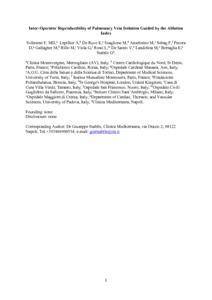Solimene, F;
Lepillier, A;
De Ruvo, E;
Scaglione, M;
Anselmino, M;
Sebag, FA;
Pecora, D;
Gallagher, MM;
Rillo, M;
Viola, G;
et al.
Solimene, F; Lepillier, A; De Ruvo, E; Scaglione, M; Anselmino, M; Sebag, FA; Pecora, D; Gallagher, MM; Rillo, M; Viola, G; Rossi, L; De Santis, V; Landolina, M; Castro, A; Grimaldi, M; Badenco, N; Del Greco, M; De Simone, A; Bertaglia, E; Stabile, G
(2019)
Reproducibility of acute pulmonary vein isolation guided by the ablation index.
Pacing Clin Electrophysiol, 42 (7).
pp. 874-881.
ISSN 1540-8159
https://doi.org/10.1111/pace.13710
SGUL Authors: Gallagher, Mark Michael
![[img]](https://openaccess.sgul.ac.uk/112616/1.hassmallThumbnailVersion/Pre%20print.pdf)  Preview |
|
PDF
Accepted Version
Available under License ["licenses_description_publisher" not defined].
Download (737kB)
| Preview
|
Abstract
BACKGROUND: Atrial fibrillation (AF) ablation outcome is still operator dependent. Ablation Index (AI) is a new lesion quality marker that has been demonstrated to allow acute durable pulmonary vein (PV) isolation followed by a high single-procedure arrhythmia-free survival. This prospective, multicenter study was designed to evaluate the reproducibility of acute PV isolation guided by the AI. METHODS: A total of 490 consecutive patients with paroxysmal (80.4%) and persistent AF underwent first time PV encircling and were divided in four study groups according to operator preference in choosing the ablation catheter (a contact force [ST] or contact force surround flow [STSF] catheter) and the AI setting (330 at posterior and 450 at anterior wall or 380 at posterior and 500 at anterior wall). Radiofrequency was delivered targeting interlesion distance ≤6 mm. RESULTS: The rate of first-pass PV isolation (ST330 90 ± 16%, ST380 87 ± 19%, STSF330 90 ± 17%, STSF380 91 ± 15%, P = .585) was similar among the four study groups, whereas procedure (ST330 129 ± 44 minutes, ST380 144 ± 44 minutes, STSF330 120 ± 72 minutes, STSF380 125 ± 73 minutes, P < .001) and fluoroscopy time (ST330 542 ± 285 seconds, ST380 540 ± 416 seconds, STSF330 257 ± 356 seconds, STSF380 379 ± 454 seconds, P < 0.001) significantly differed. The difference in the rate of first-pass isolation was not statistical different (P = .06) among the 12 operators that performed at least 15 procedures. CONCLUSIONS: An ablation protocol respecting strict criteria for contiguity and quality lesion results in high and comparable rate of acute PV isolation among operator performing ablation with different catheters, AI settings, procedure, and fluoroscopy times.
| Item Type: |
Article
|
| Additional Information: |
This is the peer reviewed version of the following article: Solimene, F, Lepillier, A, De Ruvo, E, et al. Reproducibility of acute pulmonary vein isolation guided by the ablation index. Pacing Clin Electrophysiol. 2019; 42: 874– 881, which has been published in final form at https://doi.org/10.1111/pace.13710. This article may be used for non-commercial purposes in accordance with Wiley Terms and Conditions for Use of Self-Archived Versions. |
| Keywords: |
ablation index, atrial fibrillation, catheter ablation, reproducibility, Atrial Fibrillation, Catheter Ablation, Female, Humans, Male, Middle Aged, Prospective Studies, Pulmonary Veins, Registries, Reproducibility of Results, Pulmonary Veins, Humans, Atrial Fibrillation, Catheter Ablation, Registries, Prospective Studies, Reproducibility of Results, Middle Aged, Female, Male, ablation index, atrial fibrillation, catheter ablation, reproducibility, ablation index, atrial fibrillation, catheter ablation, reproducibility, Atrial Fibrillation, Catheter Ablation, Female, Humans, Male, Middle Aged, Prospective Studies, Pulmonary Veins, Registries, Reproducibility of Results, 0903 Biomedical Engineering, 1103 Clinical Sciences, Cardiovascular System & Hematology |
| SGUL Research Institute / Research Centre: |
Academic Structure > Molecular and Clinical Sciences Research Institute (MCS) |
| Journal or Publication Title: |
Pacing Clin Electrophysiol |
| ISSN: |
1540-8159 |
| Language: |
eng |
| Publisher License: |
Publisher's own licence |
| PubMed ID: |
31045257 |
| Web of Science ID: |
WOS:000474649700014 |
| Dates: |
| Date |
Event |
| 2019-07-08 |
Published |
| 2019-05-19 |
Published Online |
| 2019-04-27 |
Accepted |
|
 |
Go to PubMed abstract |
| URI: |
https://openaccess.sgul.ac.uk/id/eprint/112616 |
| Publisher's version: |
https://doi.org/10.1111/pace.13710 |
Statistics
Item downloaded times since 18 Nov 2020.
Actions (login required)
 |
Edit Item |



